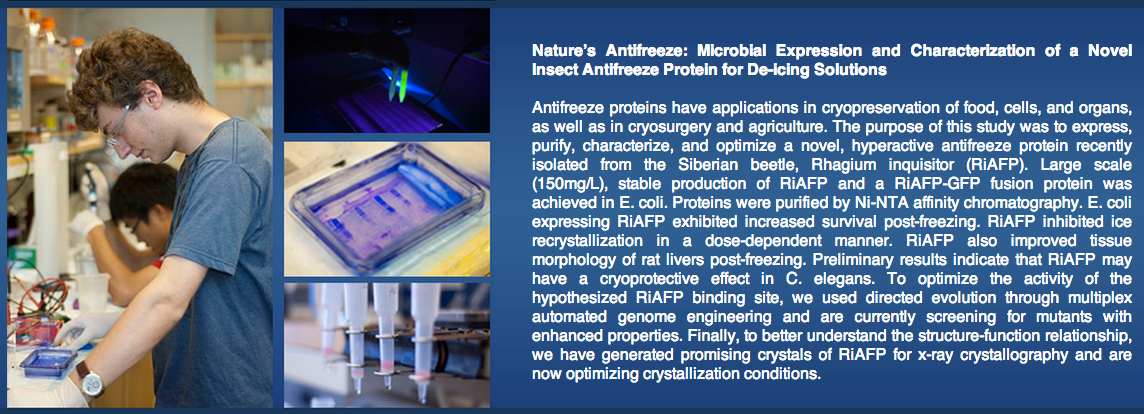Tracks/Food Energy
From 2014.igem.org
(Created page with "{{CSS/Main}} {{NavBar}} <html> <style type="text/css"> #Food_Energy {display: block;} </style> <div id="contentcontainer"> <div class="container_12"> <div class="grid_3"> ...") |
|||
| Line 26: | Line 26: | ||
<p> | <p> | ||
| - | + | Everybody needs to eat. But with over 7 billion people on the planet, the problem of producing enough food and energy is complex and multi-faceted. While nations have different ideas about cuisine, everybody needs roughly the same number of calories per day. These calories can come from many sources, but world agricultural land and water use is increasingly stretched to cope with our current population. Better solutions that don't rely on unsustainable fishing practices, increased arable land and industrial agriculture are needed to cope with our ever-expanding population. | |
</p> | </p> | ||
<p> | <p> | ||
| - | You will find images and abstracts of the winning | + | A major economic driver for most countries is energy availability and use. While natural gas, oil and coal reserves are still likely to last humanity for many hundreds of years, their distribution across the planet is not equal. The ability for a nation to produce it's own transportation fuel, irrespective available natural resources will be a huge source of economic growth in the 21st century. Synthetic biology may have the answer to some, if not all of these pressing global issues. |
| + | </p> | ||
| + | |||
| + | <p> | ||
| + | You will find images and abstracts of the winning Food or Energy teams from 2011 to 2013 in the page below. Also, follow the links below to see projects from all the Food or Energy track teams. | ||
</p> | </p> | ||
<ul> | <ul> | ||
| - | <li><a href ="https://igem.org/Team_Tracks?year=2013"> iGEM 2013 | + | <li><a href ="https://igem.org/Team_Tracks?year=2013"> iGEM 2013 Food or Energy team list</a></li> |
| - | <li><a href ="https://igem.org/Team_Tracks?year=2012"> iGEM 2012 | + | <li><a href ="https://igem.org/Team_Tracks?year=2012"> iGEM 2012 Food or Energy team list</a></li> |
| - | <li><a href ="https://igem.org/Team_Tracks?year=2011"> iGEM 2011 | + | <li><a href ="https://igem.org/Team_Tracks?year=2011"> iGEM 2011 Food or Energy team list</a></li> |
</ul> | </ul> | ||
Revision as of 21:35, 7 February 2014
iGEM 2014 Food and Energy Track
Everybody needs to eat. But with over 7 billion people on the planet, the problem of producing enough food and energy is complex and multi-faceted. While nations have different ideas about cuisine, everybody needs roughly the same number of calories per day. These calories can come from many sources, but world agricultural land and water use is increasingly stretched to cope with our current population. Better solutions that don't rely on unsustainable fishing practices, increased arable land and industrial agriculture are needed to cope with our ever-expanding population.
A major economic driver for most countries is energy availability and use. While natural gas, oil and coal reserves are still likely to last humanity for many hundreds of years, their distribution across the planet is not equal. The ability for a nation to produce it's own transportation fuel, irrespective available natural resources will be a huge source of economic growth in the 21st century. Synthetic biology may have the answer to some, if not all of these pressing global issues.
You will find images and abstracts of the winning Food or Energy teams from 2011 to 2013 in the page below. Also, follow the links below to see projects from all the Food or Energy track teams.
- iGEM 2013 Food or Energy team list
- iGEM 2012 Food or Energy team list
- iGEM 2011 Food or Energy team list
Winning Food and Energy projects in 2013
Winning Food and Energy project 2011: (Tie) Washington and Yale
Washington
Project abstract: Synthetic biology holds great promise regarding the production of important compounds, and the degradation of harmful ones. This summer, we harnessed the power of synthetic biology to meet the world's needs for fuel and medicine. Make It: We constructed a strain of Escherichia coli that produces a variety of alkanes, the main constituents of diesel fuel, by introducing a pair of genes recently shown convert fatty acid synthesis intermediates into alkanes. Break It: We identified a protease with gluten-degradation potential, and then reengineered it to have greatly increased gluten-degrading activity, allowing for the breakdown of gluten in the digestive track when taken in pill form. Finally, to enable next-generation cloning of standard biological parts, BioBrick vectors optimized for Gibson assembly were constructed and used to construct the Magnetosome Toolkit: genes for biofabrication of magnetic particles.
Yale
Project abstract: Antifreeze proteins have applications in cryopreservation of food, cells, and organs, as well as in cryosurgery and agriculture. The purpose of this study was to express, purify, and characterize a novel, hyperactive antifreeze protein recently isolated from the Siberian beetle, Rhagium inquisitor (RiAFP). Large scale (150mg/L), stable production of RiAFP and a RiAFP-GFP fusion protein was achieved in E. coli. Proteins were purified using Ni-NTA affinity chromatography. E. coli expressing RiAFP exhibited increased survival post-freezing. RiAFP inhibited ice recrystallization in both splat and capillary assay. To optimize the activity of the hypothesized RiAFP ice binding site, we are using directed evolution through multiplex automated genome engineering (MAGE). Finally, we are further optimizinge our crystallization conditions for RiAFP to better understand the structure-function relationship, as well as conducting post-freezing survival assays in C. elegans.
 "
"